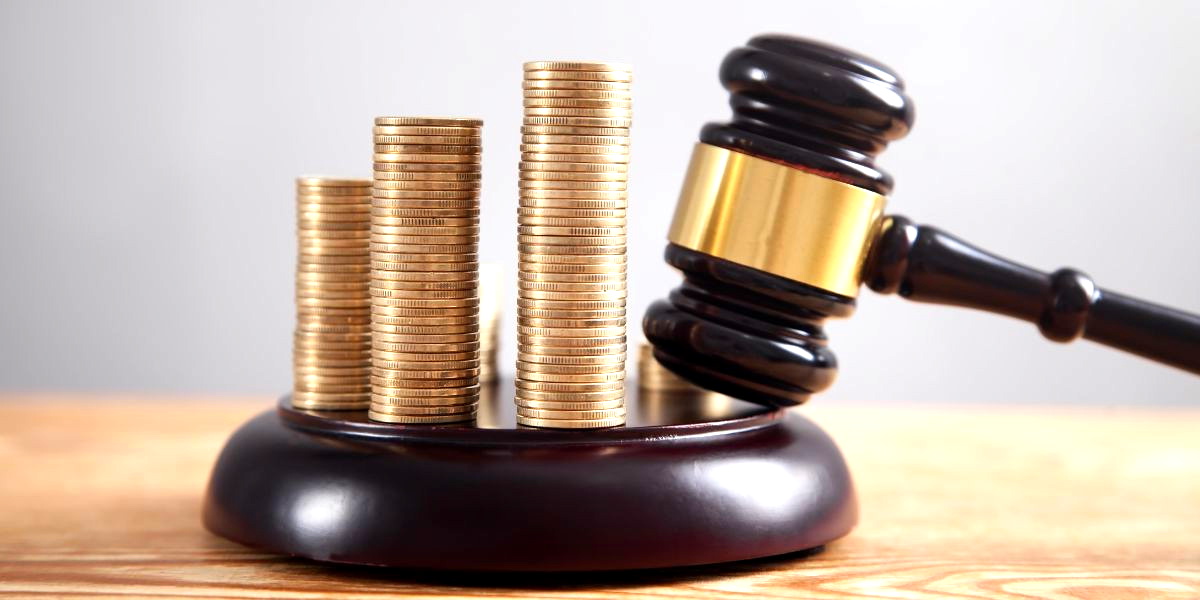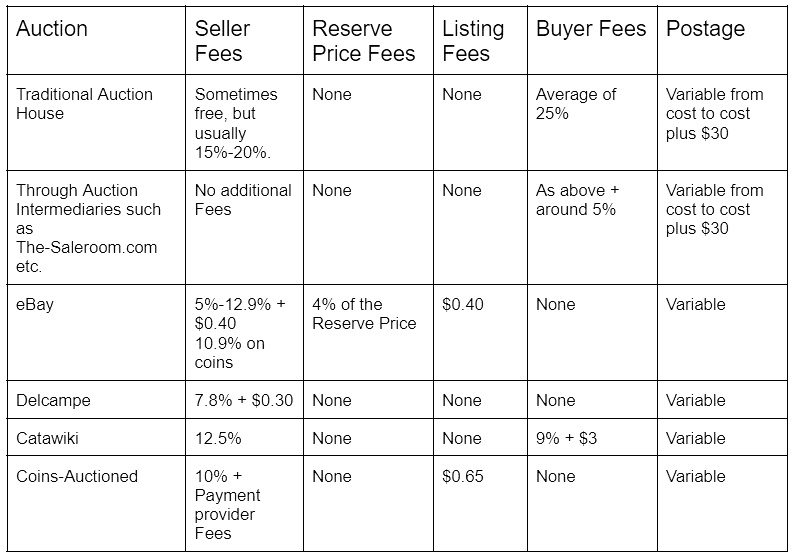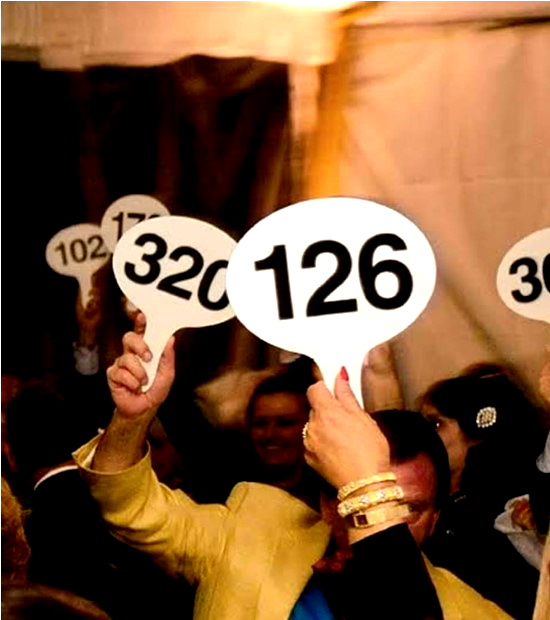
コインオークションの仕組み
このページを読んでいるということは、おそらくオークションのプロセスについてすでに興味を持っていることでしょう。すでにオークションで購入または販売したことがあるかもしれませんし、これがこの分野での初めての試みかもしれません。この記事を読み終える頃には、プロセスについてより深く理解し、自信を持って挑戦できるようになることを願っています。
では、オークションとは何でしょうか? 当然の疑問です。辞書の定義は次のとおりです。
「最も高い金額を提示した人に商品や財産が売られる公開オークション」これは「クラシック」オークションと呼ばれるものを指します。ペニーオークションやダッチオークションなどの他の種類もありますが、それほど人気がなく、必ずしも最高の結果が得られるとは限りません。
従来のオークションでは、品物、またはオークションの世界ではロットとして知られている品物が、売り手または競売人 (オークションを企画および準備する人) によって、通常は市場価格よりも低い開始価格で売りに出されます。あなたや私など、他の入札者は、オークションが終了して最高額の入札者が落札するまで入札できます。従来のオークション、つまりオークションハウス (オークションが開催される場所) での終了時間は、入札がなくなり、品物が最高額の入札者に落札されたときに決定されます。
オンライン オークションでは、通常、終了時間 (たとえば午後 7 時 30 分) が決まっています。入札はその設定された時間に終了し、その時点で最高額の入札者が落札します。その後、購入者は代金を支払って商品を受け取るか、梱包して郵便または宅配便で送ってもらいます (通常は追加料金がかかります)。

オークションの最後の入札は「ハンマー価格」と呼ばれ、従来のオークションハウスで競売人がガベル(競売人のハンマー)を叩きつけてロットの販売を終了する最終価格です。この用語は、ガベルがない場合でもオンライン オークションで使用されています。
オークションハウスやオークション Web サイトは通常、商品を販売する人に手数料を請求しますが、購入者にも手数料または料金を請求するところも多くあります。オークション料金と送料を忘れずに考慮し、予期せぬ事態を避けるためにも、必ず考慮に入れることが重要です。海外から購入する場合は、関税がかかる可能性があることも念頭に置いてください。入札は通常法的に拘束力があるため、入札する意思があるかどうか最初に確認することが重要です。
売り手としては、オークションに出品された商品を販売するための法的拘束力のある契約が通常あるため、自分の出品物が正しいこと、そしてそれを手放す意思があることを確認してください。
最低落札価格は、出品者が商品に対して受け入れる最低金額として設定する金額です。入札額がその価格を超えない場合、商品は販売されません。オークションによっては、最低落札価格を設定するために出品者に手数料を請求するところもありますが、ほとんどのオークションでは手数料はかかりません。
では、面白い部分に移りましょう。なぜオークションで購入すべきなのでしょうか? オークションには、ユニークなアイテムや入手困難なアイテムが含まれていることがよくあります。これまで見たことのない、あるいは二度と見たことのないようなアイテムもあります。
一部のオークションは「ノーリザーブ」オークションです。つまり、ロットが非常に安い、あるいは 1 ドルで売れる可能性があり、掘り出し物を手に入れることができるのです。オークションでの入札競争は、時にはかなり爽快です。オークションでの入札は楽しいだけでなく、同じような考えを持つ人々が集まり、コミュニティーになります。コレクターとしての旅を続けると、同じような、あるいはまったく異なる興味を持つ人々に出会うでしょう。私はよく、自分が見た作品を他のコレクターに知らせます。
さて、これらのロットの一部が非常に安い金額で売れる場合、売り手はなぜわざわざそうする必要があるのでしょうか。オークションは、これらのユニークなアイテムの市場価値を測る良い指標でもあります。店で買えないのに、それが「価値がある」かどうかはどうやってわかるのでしょうか。私は何度か他の人と入札合戦をしたことがありますが、予想よりもはるかに高い金額で落札されることがよくありました。2 人が同じものを十分欲しがっている場合、結果は素晴らしいものになります。オークションで販売すると、買い手にも興奮がもたらされ、買い手がまた戻ってきてさらに買いたがることがよくあります。
Coins-Auctioned.comのように、コインや紙幣に特化したオークションやサイトもあります。つまり、潜在的な購入者が 1968 年型ソブリンのような特定のものを探している場合、ダイムラーやジャガーの自動車部品 (ダイムラーとジャガーには 1968 年型ソブリンがありました) のような興味のないものが検索結果に表示されにくくなります。専門サイトは、最新のオークションを見るためにリピーターが訪れる習慣にもなります。
オークションにはいくらかかりますか? 購入者か販売者かによって異なります。以下は、いくつかの一般的なオークションルートにおける購入者と販売者のオークション手数料の表です。これらの手数料は 2023 年 8 月 31 日時点で正確でした。

上記の表は、インターネットで簡単に入手できる手数料に関する情報の公平な例です。この表を見ると、あるサイトが他のサイトよりも売り手にとって安いことは明らかですが、それは専用サイトではないという点が重要です。
では、これは 100 ドルの商品では何に相当するのでしょうか?
 上記の表は、従来のオークション、オークション サイト、オークション仲介業者を通じて 100 ドルのアイテムを購入する場合にかかる手数料の例です。購入者にとって、ロットを購入するには 3 つのより経済的な方法があることは明らかです。この 3 つのうちの 1 つである Coins-Auctioned.com は、コインと紙幣の専用サイトでもあります。認証済み販売者と Coin Sheriff プログラムの利点があるため、必要なものを見つけて正しいものであることを確認するのも簡単になります。
上記の表は、従来のオークション、オークション サイト、オークション仲介業者を通じて 100 ドルのアイテムを購入する場合にかかる手数料の例です。購入者にとって、ロットを購入するには 3 つのより経済的な方法があることは明らかです。この 3 つのうちの 1 つである Coins-Auctioned.com は、コインと紙幣の専用サイトでもあります。認証済み販売者と Coin Sheriff プログラムの利点があるため、必要なものを見つけて正しいものであることを確認するのも簡単になります。
オークションで購入するためのヒント。
オークションで購入する理由は多種多様です。何年も前から購入を計画していて、そのギャップを埋めるのにぴったりの品が出てくるのを待っているだけかもしれません。ただブラウジングしているときに何かが目に留まったのかもしれません。掘り出し物を探して、思い切って入札することにしたのかもしれません。自分用や贈り物用かもしれません。熟練したコレクターのための特別な品から、初心者がコレクションを始めるためのコインロットまで。重要なのは、体験を楽しみ、期待通りのものを手に入れることです。
どこに、どのように、いくら、何に入札するかを計画することが重要です。
どこですか?
物理的なオークションハウスですか?
それはオンラインオークションですか?
お近くでない場合は、郵送/配送のオプションと費用はいくらですか?
国際商品の場合、国外への持ち出しや国内への持ち込みに問題はありますか?
入札や支払いはどのように行いますか?
実際のオークションの場合、直接入札しますか、それとも委託入札(オークション主催者が合意した金額であなたに代わって入札する)しますか?
入札や支払いはどのように行いますか?
実際のオークションの場合、直接入札しますか、それとも委託入札(オークション主催者が合意した金額であなたに代わって入札する)しますか?
特定の時間に入札が終了する時間指定オークションですか? 時間は都合が良いですか? つまり、入札できる時間、起きている時間、仕事中でない時間に終了しますか?
入札する前に、支払いオプションを確認してください。オークションハウスによっては、一定額を超えるとカードでの支払いができず、銀行振込のみ受け付けるところもあります。
いくら払ってもいいですか?
予算はありますか?
予算を守れますか?
あなたの予算は現実的ですか? それを買う余裕はありますか? あなたの予算内でそのくじを勝ち取る可能性はありますか?
入札する前に、手数料、追加料金、送料などの追加費用を必ず確認してください。
それは何ですか?
あなたの国で購入することは合法ですか? 一部の古美術品は保護されています。
それが何であるか正確に知っていますか? 画像と説明には十分な詳細が含まれていますか? そうでない場合は、遠慮せずにさらに詳しい情報や画像を要求してください。
必ず説明を注意深く読んでください。
写真を常に注意深く見てください。
従来のオークションハウスで購入する場合、特に高額の品物を購入する場合に覚えておくべき非常に重要なことは、落札が決まり、品物があなたのものになると、多くのオークションハウスではその品物に保険をかけなくなるため、できるだけ早く受け取るか配送を手配することが重要だということです。
正しい方法でアプローチすれば、オークションでの入札は楽しい、心地よい経験になります。最初の入札または次の入札がうまくいくことを祈っています!
オークションで販売するためのヒント。
オークションで物事がスムーズに進むようにするには、いくつかのルールを準備して従うことも同様に重要です。これらのルールのいくつかは、オークションでの購入と非常に似ています。
何をお持ちですか、または何を販売したいですか?
その品物は何だか分かりますか?
それは、コレクションから出土した、十分に文書化された品物でしょうか? それとも、地面から掘り出されたコインでしょうか?
それを識別できますか?
いくらで売りたいかという予想はありますか?
あなたの期待は現実的ですか?
どこでどのように販売したいですか?
従来のオークションハウスを利用する予定ですか? その場合、特に専門家であれば、上記の識別や落札価格の見積もりなどの責任の多くを彼らが引き受けます。
一般的なオンラインオークションを利用しますか? そうであれば、あなたの作品はどのように目立つようになりますか?
専門のオンラインオークションを利用しますか?
最低入札価格を設定しますか? これはロットが販売される最低金額です。たとえば、最低入札価格を 100 ドルに設定した場合、90 ドルの入札は成功しませんが、100 ドル以上の入札は成功します。
あなたの商品が実際のオークションハウスに出品される場合、オークションハウスでは保険をかけてくれますか?保険をかけていないオークションハウスもあります。
オンラインで販売する場合は、説明文と写真を用意する必要があるでしょう。自分の持っている商品についてよく理解し、良い写真やビデオを撮れるようにしておくことは、自分の持っている商品に最高の価格をつけるために重要です。
アイテムの投稿またはエクスポートに制限はありますか? 続行する前にこれを知っておくことが重要です。
オンラインで販売する場合、オークションに出品する商品がサイトの利用規約に違反していないことを確認することが非常に重要です。

オークションハウスや購入者にどうやって届けるのですか?
従来のオークションハウスを使用する場合、オークションハウスはアイテムを回収しますか? アイテムをオークションハウスまで届ける必要がありますか? オークションハウスが地元のものであれば、それほど問題にはなりません。
Coins-Auctioned.com などのオンライン オークションの場合、アイテムは売れるまであなたの手元に残ります。
商品が売れたら、どうやって買い手に渡るのでしょうか? オークションハウスは、売り手に手数料を請求することで配送を手配できる場合があります。ただし、手数料の中には郵便料金や宅配料金よりもはるかに高いものもあり、買い手はこれを考慮に入れて、少し低い価格で入札することが多いことに注意してください。
時間がオンライン オークション会社を通じて販売される場合、売り手が配送を手配するのが一般的です。配送料も通常は買い手に請求されますが、通常はより合理的な費用で済みます。郵便または宅配便で送られる荷物には、適切な保険または補償を受けることが重要です。
繰り返しになりますが、このアイテムを別の国に送る場合、送信または受信に制限がないことを確認することが重要です。
マーケティングとプロモーション。
従来のオークションハウスは、主に既存の顧客を対象に作品を販売しますが、より重要な作品はより熱心に宣伝されることがあります。
自分で作品を販売する場合は、ソーシャル メディアにリンクを貼った投稿を使って自分で宣伝することをためらわないでください。このプロセスは、オークションが始まる前、つまり作品が見つかったときや、販売を決定したときから開始できます。販売場所を決定し、認証や格付けを取得してからオークションが始まるまでのプロセスに続くこともあります。恐れずに挑戦してください。
興奮の始まり: 販売日またはオンライン オークションが開始されたとき。
通常、オークション当日、またはオークションが開始されると、すべての潜在的な購入者が、そのロット、説明、写真、そして場合によってはその素晴らしさを実際に見ることができるようになります。
ここから入札者は、その商品が欲しいかどうか、またいくら欲しいかを決めることができます。「いくら」というのは通常、入札者が最高いくらまで入札するかを意味します。
入札者は、「手数料」または「ブック」入札(実際のオークションハウスの場合)を残すか、「自動」入札(オンラインで同等)を残すことができます。自動入札では、最高入札額が落札されるか、他の入札者が入札額を上回るまで、競売人またはオークション システムが入札者に代わって入札します。
オークションハウスで「直接」入札する場合は、実際にその場にいて、手を挙げたりパドルで示したりして入札する必要があります (下の写真を参照)。鼻をかいて誤って高額入札したという話は、かなり誇張されています。競売人はプロであり、意図的な入札と、うっかり耳をかいている人の違いを通常は見分けることができます。

オンラインオークションの場合も手順は同様で、入札者は入札したい金額を入力して「Enter」を押します。または、次に高い入札額を自動的に入力する「プラスワン」ボタンがある場合もあります。
入札増額は入札額が上がる段階です。金額が大きくなるにつれて、入札増額も大きくなります。
1 ドルから 20 ドルまでの入札増額は、1 ドル単位 (例: 1、2、3、4 など、20 ドルまで) になります。
20 ドルから 50 ドルまでは 2 ドル刻みになります (例: 20 ドル、22 ドル、24 ドル、26 ドルなど)。
50 ドルから 100 ドルまでは 5 ドル刻み、例: 50 ドル、55 ドル、60 ドルなど。
100 ドルから 200 ドルまでは 10 ドル刻みになるなどです。
非常に大きな金額の場合は、220 万ドル、230 万ドルなど、10 万ドル単位の増分になる場合があります。
きっと、その金額で売れる作品があれば、私たちみんな喜ぶでしょう。
高額な落札価格に影響を与えるものは何ですか?
最終的な落札価格を決定する要因としては、以下のいずれかの理由、またはそれらの組み合わせが考えられます。
本質的価値。貴金属などの本質的価値を持つ素材で作られた作品の場合、その素材の市場価格よりも安く売れることはめったにありません。たとえば、純金で作られた 1 キロのコインは、金の価格 (執筆時点で 62,000 米ドル) よりも安く売れる可能性は低いです。
需要と供給。1,000 人が何かを欲しがっているのに、100 枚しか入手できない場合、入札者が競い合うことで価格が上昇します。この良い例は、2009 年の英国「キューガーデン」50 ペンスです。発行時の価値は、流通コインとして 50 ペンスでした。このコインの鋳造数はわずか 210,000 枚 (「通常」の鋳造数は 3,000,000 枚以上) で、英国の 10 進コイン収集家全員が 1 枚を欲しがり、価格は 1 枚あたり約 200 ドルにまで上昇しました。
希少性。需要と供給に非常に似ています。コインが希少で、特定の造幣局や年からの希少なもの、または状態の良い希少なものであれば、価格が急上昇する可能性があります。流通していない、新品同様のジュリアス シーザーの金貨アウレウスがオークションに出品されたと想像してください。それ自体でも希少で価値のあるコインですが、そのほとんどは考古学者や金属探知機によって発掘されたものです。これに金属の柔らかさと摩耗の程度が加わると、新品同様のコインは唯一無二の掘り出し物となる可能性があります。
マーケティング。これは単純なことですが、見落とされがちです。その種類の最も重要な作品を販売していても、誰もそのことを知らない場合、最高の価格は得られません。潜在的な購入希望者に、その作品が入手可能であることを伝えることが重要です。マーケティングの誇大宣伝は、比較的普通のロットの入札額を引き上げることにもつながります。これは、タブロイド紙が国際オンラインオークションで普通のコインが驚くべき結果を得たと報道するときによく起こります。
経済状況。市場が混乱し、経済見通しが芳しくない場合、投資家は伝統的に貴金属などの実物資産の保有に移行しており、多くのコインは貴金属で作られています。近年、投資家は代替品を求めており、収集品が買い物リストに載っています。過去数年間にオークションにかけられたコインや切手の中でも最も希少なもののいくつかは、機関によって購入されました。以前は、これは博物館や国立コレクションを意味していましたが、現在では投資グループも含まれます。これは売り手にとっては素晴らしいことですが、多くの素晴らしい例がほとんどのコレクターの手の届かないところにあります。
トレンド。トレンドは、通常、真の収集品の運命に影響を与えることはありませんが、現代のオークションでは重要な部分になっています。たとえば、ジェームズ ボンドやスター ウォーズ シリーズの新しい映画が公開されると、関心が高まり、そのシリーズに関連するものの価格が上昇します。これは、たとえば国や政権が悪い行動をとっている場合など、悪評が広まると、その国や政権との関連に対する需要が減り、価格も下がります。
******グラフ画像を挿入しますか? 上昇市場/下降市場?******
ハンマー、または仮想ハンマーが落ちると、次に何が起こるでしょうか?
セール日、またはオンライン出品の最終日が終わると、次に何が起こるのでしょうか?
購入者の観点から見ると;
オークションに直接参加する場合は、代金を支払って、新たに入手した品物を持ち帰ることができる場合があります。
オークションに直接参加できず、委託入札を行った場合は、オークションハウスから支払い用の請求書が発行される可能性があります。支払いが完了したら、商品の受け取りまたは配送を手配します。
オンライン オークションまたはオークション プラットフォームで入札する場合は、支払い通知が届きます。支払いが完了したら、配送を手配します。ほとんどのオンライン オークションでは、アイテムは郵送または宅配便で配送されることが想定されており、通常、その費用は事前にリストに記載されているため、正確に予想できます。
これらすべてが完了したら、あとはくつろいで新しい商品が届くのを待つだけです。商品が届いたら、説明どおりで間違いがないかどうか確認してください。相違がある場合は、できるだけ早く販売者またはオークションに連絡してください。ほとんどの問題はすぐに解決できます。オンライン オークションでは、機会があればフィードバックやレビューを投稿することが常に重要です。他の潜在的な購入者に期待を伝えるのに役立ちます。
最後に、オークション カタログやオンライン オークションのページを見て、次に購入する魅力的な品物を探してみましょう。楽しいお買い物を!
売り手の観点から見ると;
従来のオークションハウスで販売する場合は、支払いが完了し、ロットの受け取りまたは発送が完了したことを知らせる連絡が来るまで待つだけです。その後、手数料を差し引いた支払いがオークションハウスで手配されます。
オンライン オークションで販売する場合は、必要に応じて支払いリクエストを送信します。現在では、多くの支払いが自動化されています。
支払いを受け取ったら、商品を慎重に梱包して新しい住所に郵送します。海外に送る場合は、税関情報が正しく記入されていることを確認してください。商品が紛失または破損した場合に、ご自身と購入者を保護するために、必ず郵便保険を手配してください。
商品が配達されたら、購入者が満足していることを確認し、ウェブサイトの必要に応じてフィードバックやレビューを残します。
次は、あなたが時間をかけてそのお金を何に使うかを考える番です。休暇?家のリフォーム?それともコレクションにもうひとつ加えるアイテム?
オークションでの購入や販売に挑戦したいなら、ぜひ試してみてください。どちらの方法を選んでも、刺激的でやりがいのある体験になるでしょう。幸運を祈り、楽しんでください。
毎週新しいオークションが開催されるので、 Coins Auctioned にアクセスしてください。
Coin Encyclopedia検索
最新記事
ラージセントは1793年から1857年にかけて鋳造された1セント銅貨で、アメリカ合衆国で最初の公式硬貨の一つです。代表的な種類には、リースセントとチェーンセントがあります。ラージセントの種類、価値、そして歴史を学びましょう!
11th Jul 2025
ハードタイムズ・トークンは、1830年代の経済不況時にアメリカの民間企業によって発行された非公式のコインです。ハードタイムズ・トークンの歴史、反骨精神あふれるデザイン、そしてその価値について、ここで詳しくご覧ください。
18th Jun 2025
大統領ドルは、2007年から2020年までに発行された、すべての故大統領を描いたアメリカの硬貨です。このガイドでは、大統領ドルの背景、詳細、そして価値ある種類についてご紹介します。
5th Jun 2025
記事のカテゴリ
Collection of articles providing lots of useful information on coins through the ages.
30記事数
